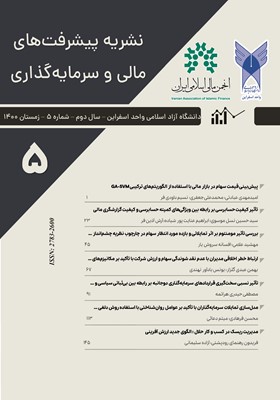مدلسازی تمایلات سرمایه گذاران با تأکید بر عوامل روانشناختی با استفاده روش دلفی فازی و دیمتل
محورهای موضوعی : اقتصاد سنجی مالی و روشهای کمّی
محسن فرهادی
1
,
میثم دعائی
2
*
![]()
1 - گروه مدیریت، دانشکده اقتصاد و مدیریت، واحد علوم تحقیقات تهران، دانشگاه آزاد اسلامی، تهران، ایران
2 - گروه مدیریت مالی، واحد اسفراین، دانشگاه آزاد اسلامی، اسفراین، ایران
کلید واژه: دیمتل, دلفی فازی, عوامل روانشناختی, مدل تمایلات سرمایه گذاران,
چکیده مقاله :
نتایج پژوهشهای انجام شده در حوزه تأمین مالی بر اساس رویکرد رفتاری، حاکی از آن است که ممکن است سرمایه گذاران، غیر منطقی باشند؛ در نتیجه، سوگیری شناختی یا عوامل روانی سرمایه گذاران، می تواند بر روی تصمیمات آنان، تأثیرگذار باشد. بنابراین، نوسان قیمت سهام، نه تنها به ارزش ذاتی نشان داده شده توسط اطلاعات حسابداری وابسته است، بلکه بر رفتار غیر منطقی سرمایه گذاران نیز متکی می باشد، که می تواند با تمایلات سرمایه گذار، سنجیده شود. از این رو با توجه به اهمیت این حوزه پژوهش حاضر به ارائه مدل تمایلات سرمایهگذاران با تأکید بر عوامل روانشناختی با روش دلفی فازی و دیمتل میپردازد. این پژوهش از نوع پژوهشهای داده بنیاد میباشد. همچنین این پژوهش از نوع پژوهشهای آمیخته میباشد که در آن از دو رویکرد مورد استفاده در علوم رفتاری یعنی کمی (دیمتل) و کیفی (دلفی فازی) استفاده میشود. بر اساس نتایج به دست آمده میتوان بیان نمود که تعلق خاطر، ابهام گریزی، خود استنادی، اطمینان بیش از حد، محافظه کاری، حسابداری ذهنی، توهم کنترل، پشیمان گریزی، بهینه بینی، داشته بیش نگری، بدبینی، رفتار گلهای، کوتاه نگری و واکنش افراطی از جمله عوامل تاثیرگذار تمایلات سرمایه گذاران با تأکید بر عوامل روانشناختی میباشند که به عنوان مدل نهایی تمایلات روانشناختی سرمایه گذاران در بورس اوراق بهادار شناخته شدهاند.
The results of research in the field of financing based on a behavioral approach suggest that investors may be irrational; As a result, investors' cognitive bias or psychological factors can influence their decisions. Thus, stock price volatility depends not only on the intrinsic value shown by accounting information, but also on the irrational behavior of investors, which can be measured by the investor's inclinations. Therefore, considering the importance of this field, the present study presents a model of investors' tendencies with emphasis on psychological factors with fuzzy Delphi and DEMATEL methods. This research is a data foundation research. Also, this research is a type of mixed research in which two approaches used in behavioral sciences, namely quantitative and qualitative, are used. The statistical population of this research is divided into two parts. The first part of the statistical population consists of financial and investment experts, which includes experts in this field, who are consulted to determine the dimensions, components and indicators, and the second part of the statistical population includes all university professors who have a doctorate in finance. And are investments. Using fuzzy Delphi method, the optimal criteria of investors 'tendencies with emphasis on psychological factors were extracted and the final model of the levels of optimal factors of investors' tendencies with emphasis on psychological factors was also drawn. Also, the effect and influence of factors on each other were evaluated using DEMATEL method.

